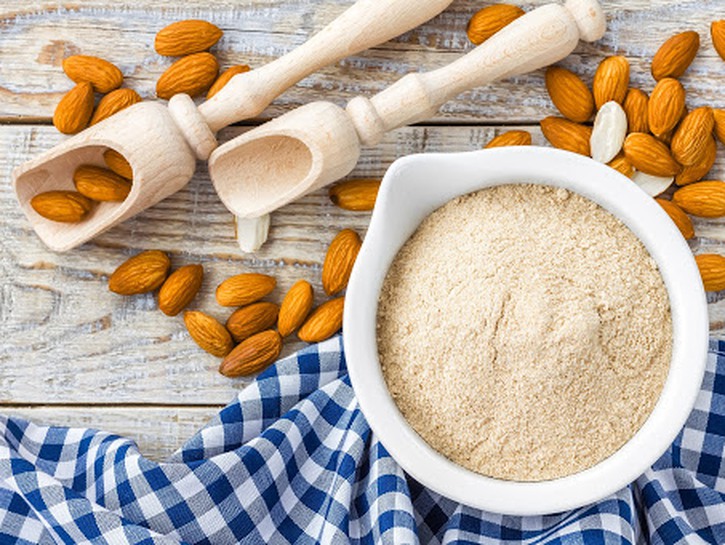Almond flour is a great alternative to regular wheat-based flours. Not only is it low carb and sweet in taste, but it’s also actually gluten-free so is safe for wheat intolerances or Celiac’s disease. The only bummer? It can be quite expensive when purchased at your local grocer. So, we’re here to save you a little bit of money with some homemade methods for creating almond flour plus some dishes to use it in. Read on for our guide to all things almond flour.
All About Almond Flour

We’ve already discussed the low carb, gluten free, and sweet nature of almond flour, but there’s much more to this stellar ingredient. Be sure to remember that almond flour is different than almond meal; meal is created from almonds with the skins on and is grittier in texture, while flour involves blanching to remove the skins then grinding into a fine consistency. Almond flour is quite nutritious as well. It is a great source of potassium, which helps keep the kidneys functioning properly, is crucial for the function of muscle and nerve cells, and helps carry electrical signals to your cells.
Almond flour is also high in fiber which is most known for keeping the digestive system moving properly, but it also helps weight loss, lowers cholesterol, and regulates blood sugar levels. Fiber is essential for leading a healthy life supported by a healthy diet. Lastly, almond flour is a good source of vitamin E, which helps to support vision and reproductive health, and has antioxidant properties. Antioxidants combat the effects of free radicals, which can lower your risk of cancer and heart disease. So as you can see, almond flour can be a great addition to a healthy pantry.
How To Make Almond Flour

We will explore a couple of ways to make almond flour at home to lower the price of this great ingredient.
Method #1: Food Processor
The first way to make homemade almond flour is with a typical blender or food processor found in any well-stocked kitchen. This method only works with pre-packaged blanched almonds, which simply means the skins have been removed. For optimum healthy points, be sure to choose unsalted and not roasted almonds.
What You’ll Need:
- blender or food processor
- fine mesh strainer
- measuring cups
Ingredients:
- 1 cup almonds (as specified above)
Instructions:
Step #1: Almonds Away
In a food processor, about 1/4 cup at a time, pulse until almonds reach a flour-like consistency. Be sure not to over-process or you will end up with nut butter.
Step #2: Sift Sift Hooray
Transfer flour to a fine mesh strainer. Re-pulse any remaining shards of almonds until they reach the same flour-like powder. Repeat straining and blending until all almonds have been processed correctly. Then, store in airtight container in the pantry for up to two months.

Method #2: Blanched Is Best
This method is necessary if the only almonds you have on hand are traditional unsalted, non-roasted almonds with skins on. Keep in mind that this approach involves a drying step so is more time-consuming.
What You’ll Need
- small saucepan
- measuring cups
- fine mesh strainer
- colander
- baking sheet
- paper towels
- food processor or blender
Ingredients
- 1 cup almonds, skin on
Instructions
Step #1: Boiling Beauty
Begin by filling a small saucepan with 2 cups of water and bringing it to a full rolling boil. Then, place almonds inside for roughly 1-2 minutes.
Step #2: Rinse + Peel
Next, drain almonds into a colander and run cold water over them to rinse. Begin removing the skins immediately, or they could become too difficult to effectively peel. They should be easy to remove in almost one piece by simply pinching and pulling the skins.
Step #3: Delicate Dry
For best results, after almonds are peeled, place them onto a baking sheet lined with paper towels for at least 5 hours. Ideally, let them dry overnight (but not any longer or they won’t retain their freshness).
Step #4: Blender Time
After almonds have been dried for an appropriate length of time, place in food processor 1/4 cup at a time and pulse until flour-like consistency.
Step #5: Strainer Success
Using fine mesh strainer, sift almonds into a container for storage. Re-blend any pieces that are too big. As with the above method, as needed repeat straining and blending until all almonds have been processed correctly.
How To Use Homemade Almond Flour

MasterQ/Shutterstock
Now that we’ve mastered a couple ways to make homemade almond flour, let’s discuss how to properly use it. Since it is a different consistency than traditional flour, for baking purposes it’s best to substitute 1/2 or 1/3 of a cup for 1 cup of normal flour. In this way, almond flour can be used for cakes, cookies, crepes, almost anything you’d bake at home. Almond flour can also be used in place of bread crumbs for a more nutritious coating. In this instance, it can be substituted with a 1:1 ratio.
We hope you’ve found this guide to almond flour helpful. We can’t wait to see all the ways you use this superstar ingredient!
